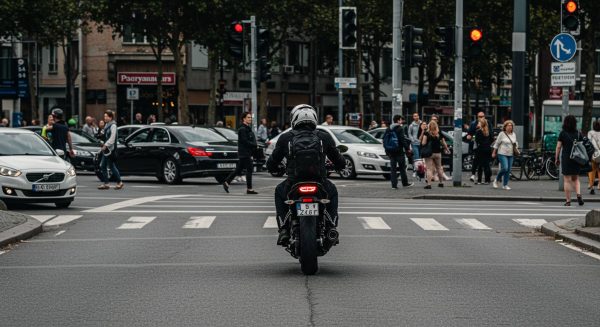One of the most significant hazards for motorcyclists is simply not being seen by other road users. According to Transport for London, around 60% of motorcyclists killed or seriously injured in London were riding 125cc or lower machines, where visibility can be particularly challenging. Drivers often claim “I just didn’t see you” in motorcycle accidents, making it crucial to maximise your visibility through proper positioning and using dipped headlights even during daylight hours.
Adverse Weather Conditions
British weather presents particular challenges for motorcyclists. Rain doesn’t just reduce visibility; it also affects road grip and can lead to aquaplaning, where your tyres lose contact with the road surface. Strong winds can be especially hazardous, potentially pushing you into different road positions or affecting stability through bends. In winter, ice and snow make riding particularly treacherous, while summer sun glare can temporarily blind both you and other road users.

Road Surface Hazards
The UK’s roads present numerous surface hazards that may be minor inconveniences for cars but can be serious risks for motorcyclists. These include inspection covers, especially when wet, potholes, diesel spills, loose gravel, and painted road markings. Fallen leaves in autumn can be particularly treacherous as they hide the road surface beneath and become extremely slippery when wet.
Junction Dangers
Junctions represent one of the most dangerous scenarios for motorcyclists, particularly when other vehicles are turning right across your path. Riders are particularly vulnerable at junctions and roundabouts compared to other road users. Always assume that other road users haven’t seen you and position yourself to maximise visibility without compromising your safety.
Filtering Risks
While filtering past stationary or slow-moving traffic is legal in the UK, it comes with specific hazards. Other road users may not expect you to be between lanes of traffic, and their view of you might be obscured. Pay particular attention to gaps in traffic where vehicles might suddenly change lanes or pedestrians might try to cross between stationary vehicles.

Blind Spots and Observation
Modern vehicles, especially large vans and lorries, can have significant blind spots. Left-hand drive vehicles pose a particular risk as their blind spots differ from UK vehicles. Meanwhile, your own visibility can be affected by your helmet’s design, which may limit peripheral vision. Regular ‘lifesaver’ checks—a last look over your shoulder before changing positions—are essential.
Speed and Distance Management
Inappropriate speed, particularly through bends, remains a significant hazard. Remember that your stopping distance consists of both thinking distance and braking distance. Both increase dramatically with speed and in adverse weather conditions. Maintain appropriate separation from other vehicles to give yourself time to react to sudden changes in traffic flow or road conditions.
To stay safe on the roads, it’s essential to maintain constant awareness of these hazards and develop a systematic approach to dealing with them. Good training can help. Remember that while hazards are ever-present, most can be managed effectively through proper observation, anticipation, and appropriate riding techniques.
